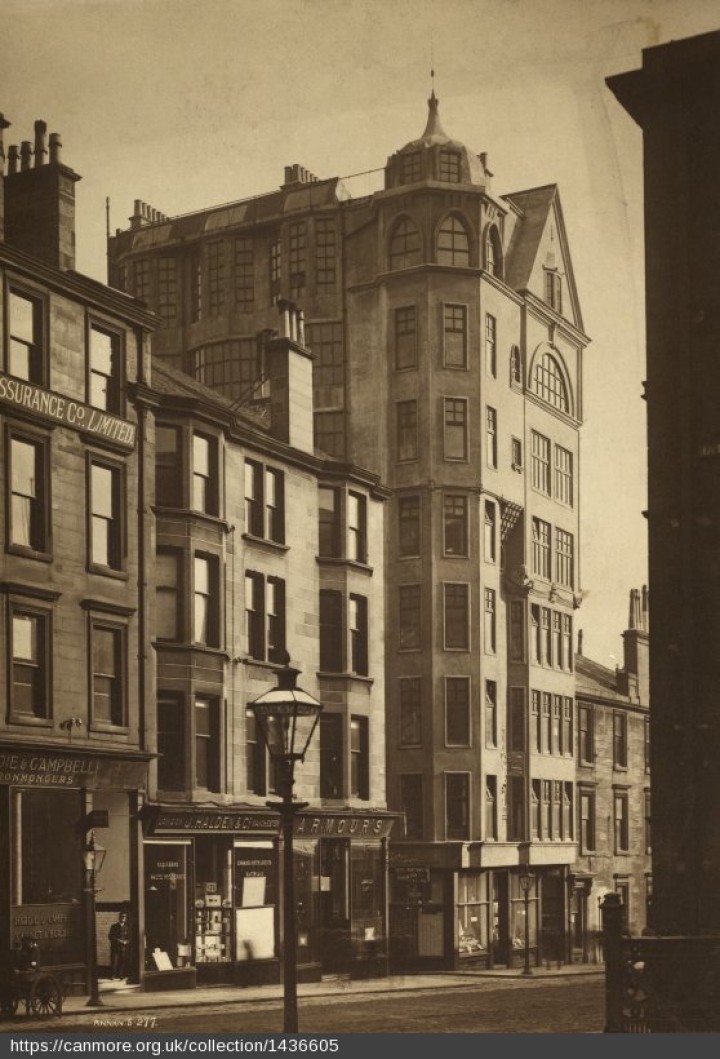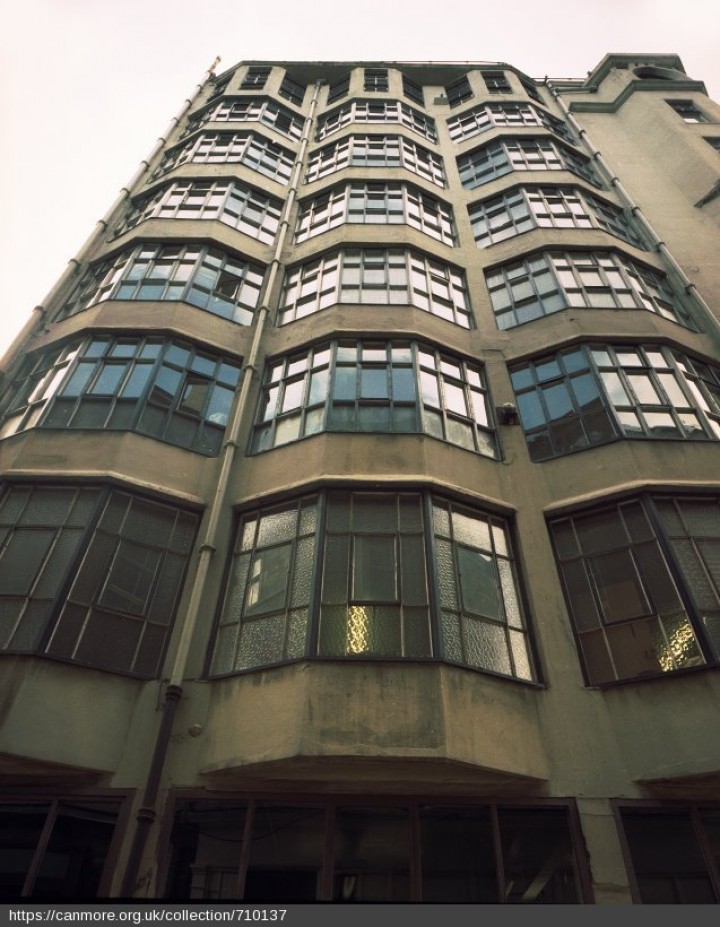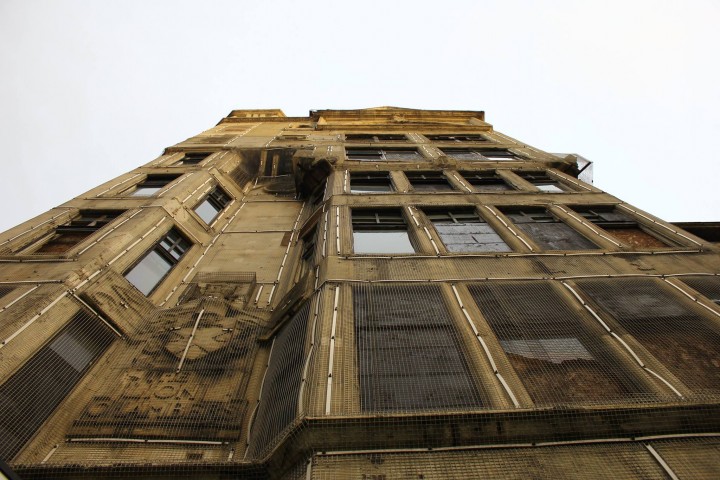Scottish Art News
Latest news
Magazine
News & Press
Publications
My Favourite Scottish Work of Art: John McAslan
By John McAslan, 17.03.2022

I can't, I'm afraid, allow myself the indulgence of selecting a beautiful work of art, cherished in an art gallery, for reasons which will become clear. Instead, I’ve gone back to my roots in Glasgow and picked one of its greatest buildings - James Salmon's Lion Chambers in Hope Street. This little tower, built 1904-07, was the first building in Scotland to be constructed on the Hennebique system, allowing you to build taller and thinner using a reinforced-concrete frame. It has been hailed by architectural historians like Nikolaus Pevsner as a pioneering modernist structure earning a Grade A listed status. And yet today the Lion Chambers deserves more attention than ever as it stands in a derelict state, semi-ruinous, like too many of Glasgow’s most significant buildings.
It makes one ask why Glasgow is so careless with its priceless architecture?
James Salmon, who was a friend and contemporary of Mackintosh, is probably known for his ‘Hat Rack’ building in St Vincent Street, which has been claimed as the finest expression of art nouveau design in the city. Lion Chambers is more complicated to define. Commissioned by a lawyer, who was a member of the Glasgow Arts Club, it was designed to house a printing works in the basement, a shop, law chambers and artists’ studios at the very top. The principal elevation is a kind of keep tower with Dutch Gables and a cupola, the front enriched with sculpture including busts of judges.
 Lion Chambers View of North front, to Bath Lane. Available at: https://canmore.org.uk/collection/710137
Lion Chambers View of North front, to Bath Lane. Available at: https://canmore.org.uk/collection/710137
Standing back from the building for a moment, it makes me think of the phenomenal heritage of Glasgow’s architecture from the 13th century cathedral to the Victorian boom in architects such as Alexander ‘Greek’ Thomson to Salmon and his partner John Gaff Gillespie and of course to Mackintosh, who was the one‐off, soaring genius. The difference between Mackintosh’s buildings and those of his contemporaries, such as Salmon, is that his sit independent to their context. They are not knitted into the fabric of the city, unlike those by Salmon and his peers. Mackintosh made great independent buildings. He’s not good at party walls! However, Salmon was hugely influential in creating a line of descent, through his partner, Gillespie, to the next generation of one‐off talents, William Kidd, Jack Coia, Andy MacMillan and Isi Metzstein, whose love of statement architecture can be traced back to Mackintosh.
I want to turn again to Lion Chambers to highlight that Salmon was also a highly original and radical. Its side elevation on the narrow West Regent Lane is a rippling wall of glass going up eight stories forming bays of steel framed windows, which would not look out of place in a contemporary building. Here Salmon used the thinness of the concrete to maximum effect. I just love this expression of construction which is why I have chosen his last great building as my favourite Scottish work of art. Go see Lion Chambers, unloved, uncelebrated, before it is too late.
 An upward view of Lion Chambers today, now derelict. Image available through a Creative Commons Attribution-ShareAlike 4.0 License at https://en.wikipedia.org/wiki/File:Lionchambers3.jpg.
An upward view of Lion Chambers today, now derelict. Image available through a Creative Commons Attribution-ShareAlike 4.0 License at https://en.wikipedia.org/wiki/File:Lionchambers3.jpg.
John McAslan CBE, was born in 1954 in Glasgow, but grew up in Dunoon. However his roots in Glasgow run deep: his maternal grandfather, John Renwick wrote volume 1 of the first official history of Glasgow. He is also indebted to him for his numeracy explaining: “He was a lawyer who collected all the feu duties on dwellings for the ledgers.” McAslan studied architecture at Edinburgh but also trained in America with Cambridge Seven Associates, a hugely influential practice with modernist roots, where he met Richard Rogers who offered him a job. McAslan first came to prominence as a partner in Troughton McAslan with a tower in Canary Wharf, inspired by streamlined early modernist buildings.
In 1993, McAslan founded John McAslan Partners, which has been responsible for landmark public buildings across the globe. He is an acclaimed adapter of historic structures notably King’s Cross Station with its ‘half umbrella’ canopy which creates an unforgettable send-off for travellers to Scotland. McAslan has just completed the restoration of the Burrell collection art gallery in Pollok Estate on the south side of Glasgow , which is typically respectful of the existing 1980s building although he has inserted an ‘Agora’ as a focal circulation point to Sir William Burrell’s treasures. “Let people use it” he says “allow it to become familiar and immersive as part of the democratisation of art”. The Burrell Collection reopens on 29th March.
McAslan’s philanthropic initiatives include his rescue with his wife Dava in 2017 of Dunoon Burgh Hall which they have transformed into a dynamic centre for contemporary arts including a series of socially focussed projects that address the scourge of homelessness.
 John McAslan in Kings Cross Station.
John McAslan in Kings Cross Station.
James Salmon Jnr (1873-1924) was the third generation in his family to become an architect. His grandfather, also called James, was a classical architect of considerable refinement, while his father, Forrest Salmon, was more of a business-getter. Having joined the family firm aged 16, Salmon Jnr was sent to train under the arts and crafts architect William Leiper. Rejoining the firm, Salmon, who was well travelled in Europe and well versed in the use of sculpture in architecture, went on to produce the iconic ‘Hatrack” building at 142a-144 St Vincent Street, which echoes Lion Chambers with a rippling red sandstone and glass elevation; and which has been compared to the work of the Catalan architect Antoni Gaudi.
Salmon's legacy as one of the finest architects of the Glasgow Style is also to be found in a handful of other innovative buildings such as Mercantile Chambers in Bothwell Street. He was elected a fellow of the RIBA in 1906. Salmon left the practice in 1911, setting up his own company in Greenock to work for the Admiralty. He died in 1924 aged 51.




